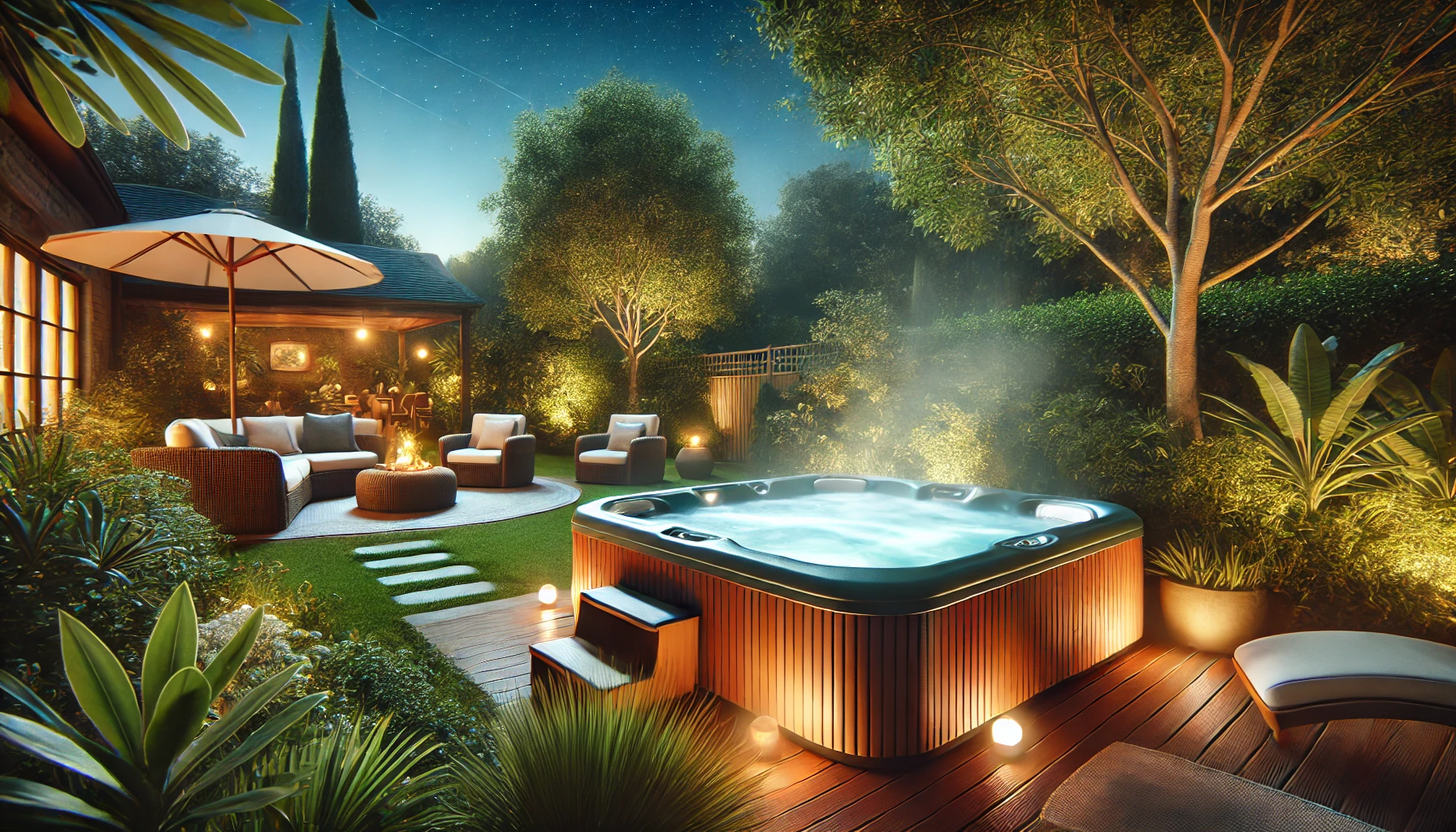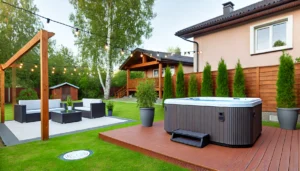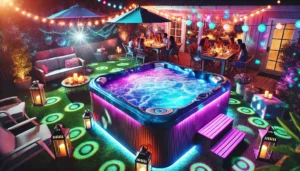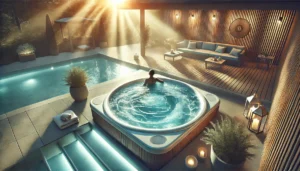Hey there, hot tub enthusiasts! Ever found yourself scratching your head, wondering about the electrical mumbo-jumbo behind your backyard oasis?
Well, you’re not alone! I remember when I first decided to install a hot tub at my place – talk about a shocking experience (pun intended)! 😅
Today, we’re diving deep into the world of hot tub electricity, specifically answering the burning question: How many amps does it take to run a hot tub? Trust me, understanding this is crucial, whether you’re a hot tub newbie or a seasoned soaker looking to upgrade.
Get ready for a splashing good time as we unravel the mysteries of hot tub amperage together!
Before we jump in, let me share a mind-boggling stat: Did you know that a typical hot tub can use as much electricity as 10 refrigerators combined? Yep, you heard that right!
But don’t let that scare you off – with the right knowledge, you can enjoy your hot tub without breaking the bank or blowing a fuse. So, let’s get this party started and turn up the heat on our hot tub knowledge!
How Many Amps Does It Take to Run a Hot Tub?
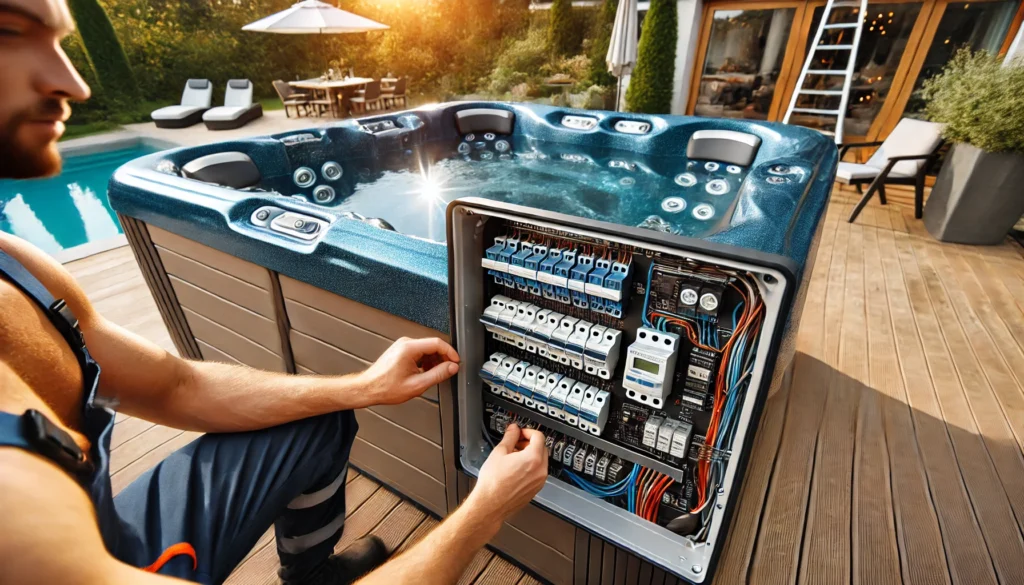
Most hot tubs require between 30 to 60 amps to run effectively, depending on their size and features. Smaller hot tubs typically need a 30-amp or 40-amp circuit, while larger models with more jets and heaters may require up to 60 amps.
It’s crucial to check your specific hot tub’s manual for exact requirements, as using the wrong amperage can lead to poor performance or safety issues. I’ve learned this the hard way, and trust me, it’s not fun!
We’ll dive deeper into the nitty-gritty of hot tub amperage below, but this should give you a good starting point.
Understanding Hot Tub Electrical Requirements
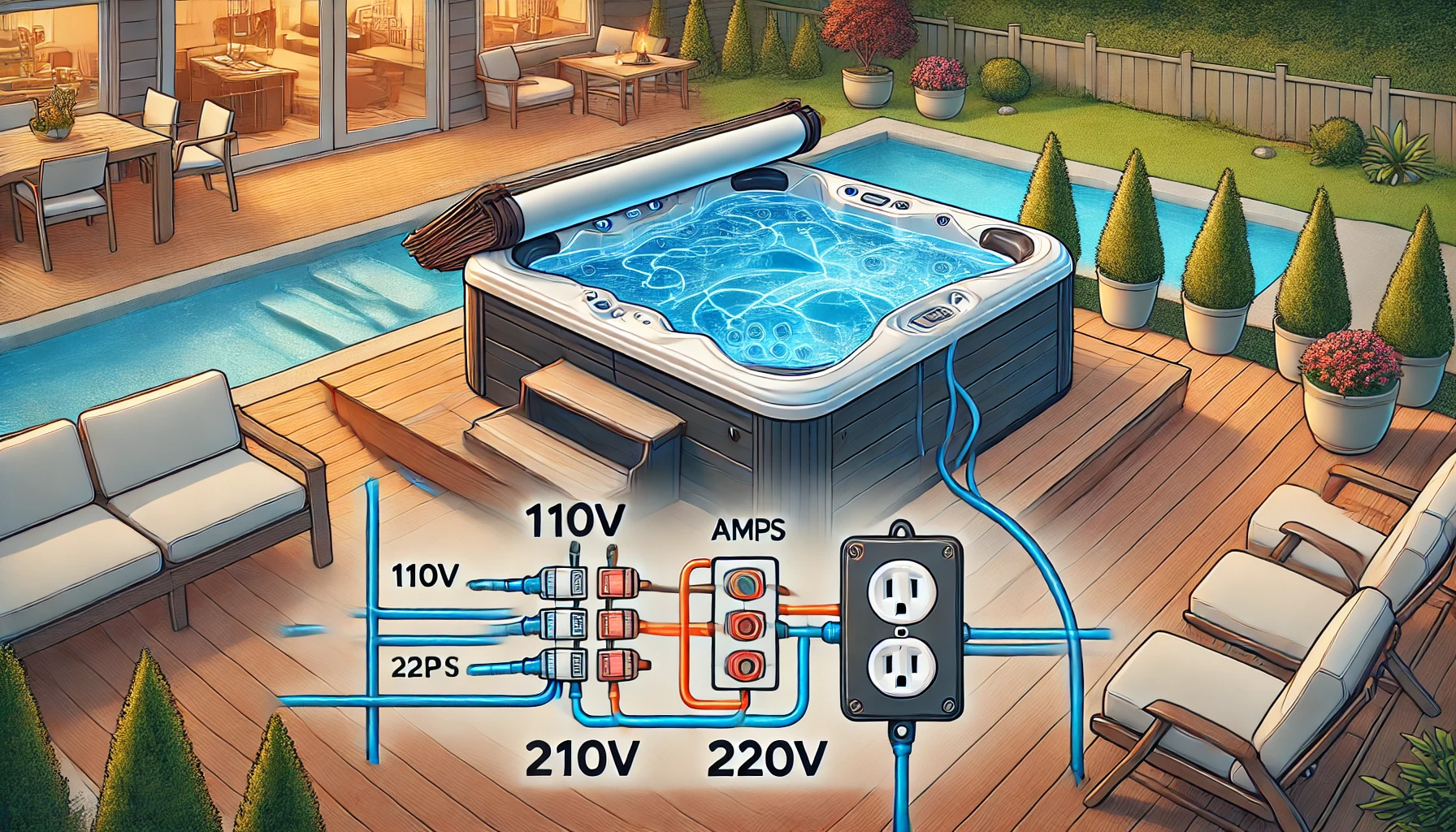
Alright, folks, let’s start with the basics – and I mean really basic. Remember high school physics?
No? Well, don’t worry, I barely do either! But here’s the deal: when it comes to hot tubs, we’re dealing with three main electrical concepts: volts, amps, and watts. Think of it like this: volts are like the water pressure in a hose, amps are the amount of water flowing through, and watts are the total water output.
Got it? Great!
Now, why do we care about amps when it comes to hot tubs? Well, let me tell ya, it’s pretty darn important!
Amps are like the muscle behind your hot tub’s operation. They determine how much electrical current your hot tub can handle. Too few amps, and your hot tub might be as exciting as a lukewarm bath.
Too many, and you could be in for a real shock – literally!
Most hot tubs out there run on either 110V or 220V. It’s like choosing between regular and premium gas for your car, except this choice was probably made for you when you bought your hot tub.
110V tubs are your plug-and-play models – super convenient, but a bit limited in power. On the other hand, 220V tubs are like the bodybuilders of the hot tub world – they need more electrical oomph, but boy, do they perform!
I remember when I first got my hot tub, I thought I could just plug it into any old outlet. Ha! Rookie mistake!
Turns out, my fancy new spa needed a dedicated 220V line. Let’s just say my electrician had a good laugh at my expense. But hey, live and learn, right?
The key takeaway here is that understanding your hot tub’s electrical requirements is crucial. It’s not just about keeping your tub running smoothly – it’s about safety too.
Trust me, you don’t want to mess around with electricity, especially when water’s involved. So, take the time to get familiar with your hot tub’s needs. Your future self (and your electrician) will thank you!
Factors Affecting Hot Tub Amperage Needs

Alright, buckle up, hot tub aficionados! We’re about to dive into the factors that determine just how many amps your bubbly paradise needs.
It’s like a recipe – throw in a pinch of this, a dash of that, and voila! You’ve got your hot tub’s power requirements.
First up, let’s talk size. In the world of hot tubs, size really does matter!
I learned this the hard way when I tried to upgrade from my cozy two-seater to a party-sized eight-person tub. Boy, was I in for a surprise! Bigger tubs need more power to heat all that extra water and keep it toasty.
It’s like trying to heat a swimming pool with a kettle – ain’t gonna happen without some serious juice!
Next, let’s chat about jets. Oh, those wonderful, muscle-melting jets!
The more jets you have, and the more powerful they are, the more amps you’re gonna need. It’s like trying to power a fleet of tiny submarines in your tub. I once stayed at a fancy resort with a hot tub that had so many jets, I felt like I was in a human washing machine.
Exhilarating? Yes. Power-hungry? You bet!
Now, onto the heater. This bad boy is like the heart of your hot tub, pumping warm water instead of blood.
The wattage of your heater plays a big role in determining your amperage needs. Higher wattage means faster heating and better temperature maintenance, but it also means a bigger appetite for electricity. It’s a balancing act between comfort and your electric bill!
But wait, there’s more! Don’t forget about all those fancy add-ons.
Lights, sound systems, water features – they all need power too. I once got carried away and decked out my hot tub with a light show that would put Times Square to shame. Let’s just say my electric meter started spinning like a disco ball!
The bottom line? When it comes to hot tub amperage needs, it’s not just about one thing.
It’s the whole package – size, jets, heater, and extras – that determines how many amps you’ll need. So next time you’re hot tub shopping, remember: with great features comes great power responsibility!
Typical Amperage Ranges for Different Hot Tub Types
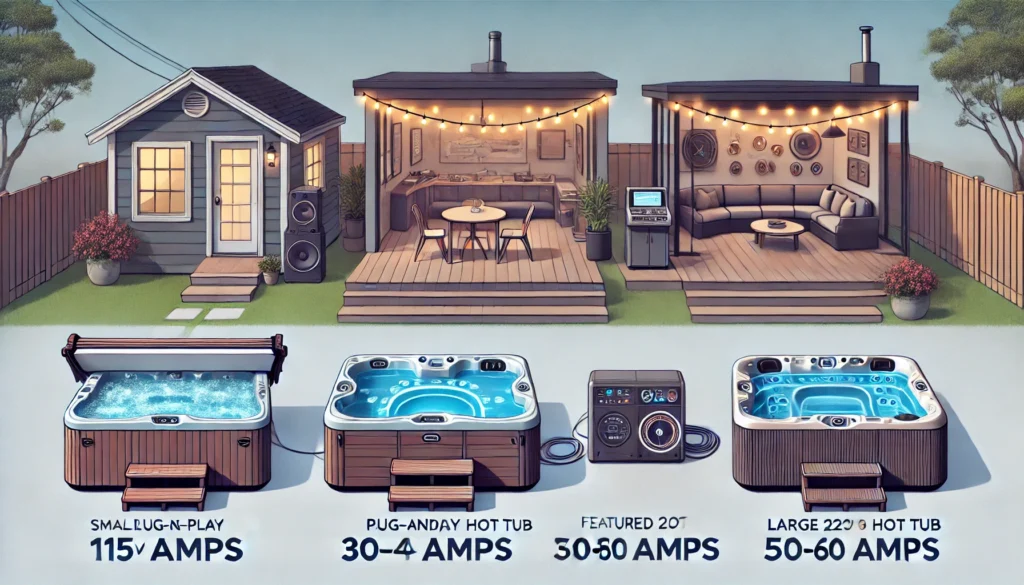
Alright, hot tub enthusiasts, it’s time to get specific! Let’s break down the typical amperage ranges for different types of hot tubs.
It’s like a hot tub buffet – there’s something for everyone, from the casual soaker to the luxury spa aficionado.
Let’s start with the small fries: plug-and-play hot tubs. These little beauties run on 110V and typically need about 15 amps.
They’re the convenience kings of the hot tub world. Just plug ’em in, fill ’em up, and you’re good to go! I had one of these in my first apartment. It wasn’t fancy, but boy, did it do the trick after a long day!
The downside? They can be a bit slow to heat up and might struggle to keep the temperature steady if it’s freezing outside.
Moving up the ladder, we’ve got the medium-sized hot tubs. These are your 220V models, usually requiring between 30 to 40 amps.
They’re like the Goldilocks of hot tubs – not too big, not too small, just right for most folks. I upgraded to one of these babies a few years back, and let me tell you, the difference was night and day! Faster heating, better jet power, and it could handle a Wisconsin winter like a champ.
Now, for the big kahunas: large, feature-rich hot tubs. These bad boys typically need 50 to 60 amps of power.
We’re talking about spas with all the bells and whistles – powerful jets, multi-pump systems, advanced heating, maybe even a built-in sound system or waterfall feature. I once house-sat for a friend who had one of these. It was like soaking in a luxury space pod!
But fair warning: these power-hungry beasts might make your electric meter spin faster than a DJ’s turntable.
Here’s a pro tip I learned the hard way: always check the manufacturer’s specs for your specific model. I once assumed my new hot tub would be fine on my existing 30-amp circuit.
Big mistake! Turns out, it needed 50 amps. Cue an emergency call to my electrician and a hefty upgrade bill. Don’t be like me – do your homework!
Remember, these are just typical ranges. Your mileage may vary depending on the specific features and efficiency of your hot tub.
It’s always better to have a bit more electrical capacity than you need, rather than not enough. Trust me, there’s nothing worse than trying to enjoy a relaxing soak while your circuit breaker plays on-again-off-again games with your hot tub!
How to Determine Your Hot Tub’s Amperage Requirements
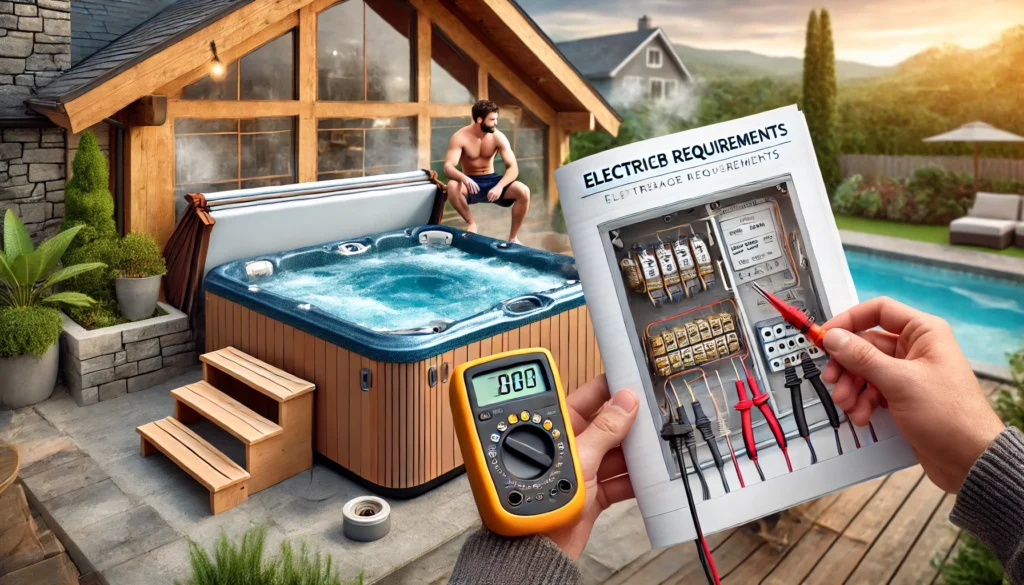
Alright, folks, it’s time to put on our detective hats and figure out exactly how many amps your hot tub needs. Don’t worry, it’s not rocket science – although sometimes it feels like it might as well be!
First things first, check the manufacturer’s specifications. This should be your go-to move.
The manual that came with your hot tub (you know, the one you probably used as a coaster) is a goldmine of information. Look for a section on electrical requirements – it should spell out exactly what you need. I remember when I got my first hot tub, I was so excited I nearly tossed the manual in the recycling bin.
Big mistake! That little booklet saved me from making some pretty shocking errors (pun intended).
If you’re like me and have a talent for losing manuals, don’t sweat it. Most manufacturers have their specs available online.
Just punch in your model number, and voila! All the electrical info you need at your fingertips. It’s like magic, but with less rabbits and top hats.
Now, if you’re still scratching your head or dealing with an older model that’s more mysterious than the Loch Ness monster, it might be time to call in the big guns. And by big guns, I mean a professional electrician.
These folks know their amps from their ohms and can figure out exactly what your hot tub needs. Plus, they can check if your home’s electrical system is up to the task. Trust me, it’s worth the call – I learned this the hard way after a DIY disaster that left me with a very angry spouse and a very cold hot tub.
For the math whizzes out there, you can also try calculating the total power draw yourself. Add up the wattage of all the components (heater, pumps, blower, etc.) and divide by the voltage.
This gives you the amperage. But fair warning: this method is about as fun as doing your taxes and just as likely to give you a headache.
Here’s a real-life example: My neighbor bought a second-hand hot tub without any documentation. She was determined to figure out the amperage herself.
I watched her spend an entire weekend with a multimeter, a calculator, and a increasingly colorful vocabulary. In the end, she called an electrician who sorted it out in about 15 minutes. The moral of the story?
Sometimes, it pays to ask for help!
Remember, when it comes to electricity, it’s always better to be safe than sorry. If you’re not 100% sure about your hot tub’s amperage requirements, don’t guess – get professional help.
Your safety (and your hot tub’s longevity) depends on it!
Electrical Safety Considerations for Hot Tub Installation
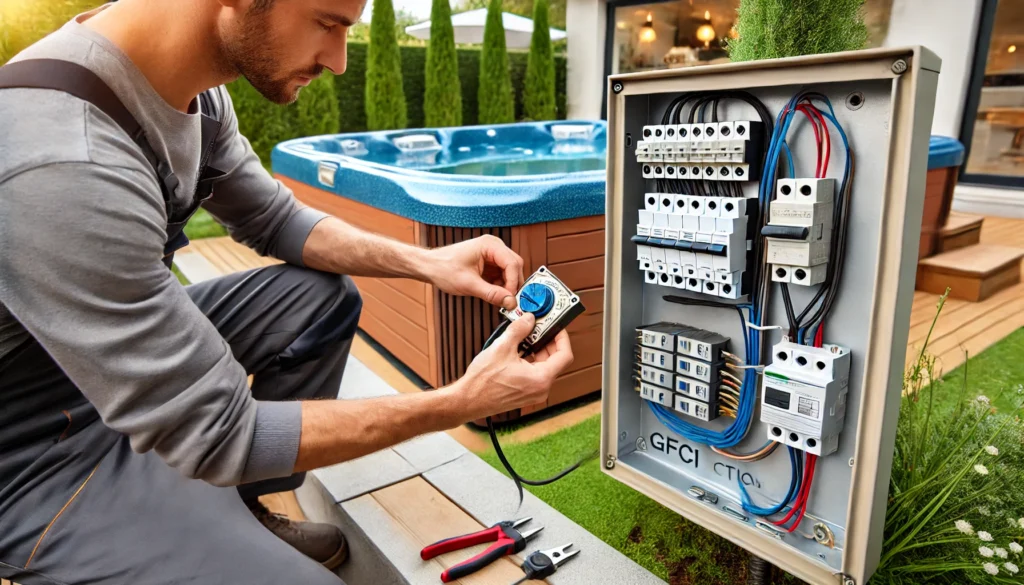
Listen up, folks, ’cause this is the serious part. We’re talking electrical safety for hot tub installation, and trust me, this isn’t something you want to mess around with.
Water and electricity are a match made in heaven for your hot tub, but they’re a disaster waiting to happen if not handled properly.
First things first: GFCI protection. That stands for Ground Fault Circuit Interrupter, and it’s your hot tub’s guardian angel.
A GFCI monitors the electrical current and shuts everything down if it detects any imbalance. It’s like having a super-vigilant lifeguard for your electrical system. I learned about the importance of GFCIs the hard way when a friend’s non-GFCI protected hot tub gave him a shock that made his hair stand on end for a week.
Not fun, and definitely not safe!
Next up, let’s talk about proper wiring and circuit breaker sizing. This isn’t the place to cut corners or get creative.
Your hot tub needs a dedicated circuit with the right size wire and breaker. Using a circuit that’s too small is like trying to quench an elephant’s thirst with a sippy cup – it just won’t cut it. On the flip side, going too big isn’t smart either.
It’s all about finding that Goldilocks zone.
Now, here’s the most important tip I can give you: hire a professional for the installation. I know, I know, we all like to think we’re secret electricians, but trust me on this one.
I once thought I could install my hot tub myself. Long story short, I ended up with a scorched outlet, a very angry wife, and an electrician who couldn’t stop laughing at my “handiwork.” Learn from my mistakes, people!
A professional electrician will make sure everything is up to code, properly grounded, and safe as houses. They’ll know all the local regulations (which, by the way, can be trickier than a Rubik’s cube) and make sure your installation passes inspection with flying colors.
Remember, we’re talking about a large body of water with electrical components. It’s not the place to channel your inner DIY spirit.
I’ve seen too many horror stories of improperly installed hot tubs turning into unexpected shock therapy sessions. Don’t be that guy (or gal).
So, do yourself a favor: when it comes to hot tub electrical installation, leave it to the pros. Your future self (and your loved ones) will thank you.
Plus, you’ll be able to enjoy your hot tub with peace of mind, knowing that everything is safe and sound. Now that’s what I call a relaxing soak!
Tips for Efficient Hot Tub Operation and Energy Savings

Alright, hot tub aficionados, let’s talk about keeping your aquatic oasis running smoothly without breaking the bank. I’ve learned a thing or two about efficient hot tub operation over the years, mostly through trial and error (and a few eye-watering electricity bills).
So, buckle up, and let’s dive into some energy-saving tips!
First up, let’s talk about the unsung hero of hot tub efficiency: the cover. A well-insulated cover is like a cozy blanket for your hot tub, keeping all that precious heat where it belongs.
I learned this lesson the hard way when my old cover started looking more like Swiss cheese than a heat barrier. My electric bill shot up faster than a rocket, and my hot tub was about as warm as a polar bear’s swimming pool. Invest in a good cover, folks.
Your wallet (and your goosebumps) will thank you.
Next, let’s chat about temperature settings. I know, I know, cranking up the heat to tropical levels is tempting.
But trust me, your hot tub doesn’t need to double as a lobster pot to be enjoyable. I’ve found that keeping the temperature around 100-102°F (38-39°C) is the sweet spot. It’s warm enough to be cozy but won’t have your electric meter spinning like a ceiling fan.
And here’s a pro tip: if you’re not planning to use your tub for a few days, turn the temperature down a few degrees. It’s like putting your hot tub in power-saving mode!
Now, let’s dive into the wonderful world of water chemistry. Keeping your water balanced isn’t just about avoiding the ick factor – it’s also key to energy efficiency.
Imbalanced water can make your heater and pumps work overtime, which is about as efficient as trying to fill a bathtub with a teaspoon. I once let my pH levels get out of whack, and my poor hot tub sounded like it was trying to launch into space every time it kicked on.
A weekly check and adjustment can save you a ton of headaches (and cash) in the long run.
Last but not least, let’s talk maintenance. Regular upkeep is like giving your hot tub a spa day – it keeps everything running smoothly and efficiently.
Clean those filters, check for leaks, and make sure your pumps and jets are debris-free. I learned this lesson after ignoring a small leak for weeks. By the time I got around to fixing it, my hot tub had turned into a miniature Niagara Falls, and my energy bill looked like a phone number.
Don’t be like me – a little preventative maintenance goes a long way!
Oh, and here’s a bonus tip I picked up from a hot tub guru: use your hot tub’s programming features. Most modern tubs let you set heating cycles.
Program it to heat up just before you usually use it, rather than maintaining max temperature 24/7. It’s like having a hot tub butler who knows exactly when you want your aquatic throne ready!
Remember, an efficient hot tub is a happy hot tub. And a happy hot tub means a happy you – both in terms of soaking pleasure and when the electricity bill arrives.
Conclusion
Whew! We’ve taken quite the journey through the electrifying world of hot tub amperage, haven’t we? From understanding the basics of electrical requirements to diving deep into energy-saving tips, we’ve covered it all.
And let me tell you, after all these years of hot tub ownership, I’m still learning new tricks!
Remember, folks, when it comes to hot tubs, knowledge is power – literally! Understanding your tub’s amperage needs isn’t just about keeping it running; it’s about safety, efficiency, and making sure you can enjoy your aquatic paradise without any shocking surprises (pun absolutely intended).
Whether you’re rocking a cozy 110V plug-and-play model or a luxurious 60-amp behemoth, the key is to know your tub’s needs and respect the power of electricity. Trust me, I’ve learned the hard way that cutting corners with electrical setups is about as smart as trying to toast marshmallows in your hot tub – it might seem like a good idea at the time, but it never ends well!
Now, I encourage you to take what you’ve learned here and apply it to your own hot tub setup. Maybe you’ll find ways to make your tub more energy-efficient, or perhaps you’ll realize it’s time to call in a pro for a safety check.
Whatever the case, remember that a well-maintained, properly powered hot tub is a joy that keeps on giving.
And hey, if you’ve got any hot tub tales of your own – triumphs, disasters, or anything in between – why not share them in the comments? We hot tub enthusiasts have to stick together, after all.
Who knows, your story might just save someone else from making the same mistakes we did!
So here’s to safe, efficient, and utterly relaxing hot tub experiences. May your water be warm, your electric bills reasonable, and your soaks long and leisurely.
Now, if you’ll excuse me, I think it’s time for me to take a dip in my own little slice of backyard paradise. Happy soaking, everyone!
